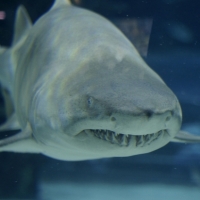Autonomous Underwater Robots Track Sharks Like Never Before

We may have just wrapped up Shark Week 2013, but studying sharks is a year-round job. And these new trackers don’t need breaks.
Researchers at California State University, Long Beach’s Shark Lab, which is committed to the study of the sensory biology and behavior of sharks, have created shark-tracking robots that can gather information about the predators and their environments better than humans can. The robot gets close enough to the radio-tagged sharks to monitor them but stays far enough away to remain undetected, so the sharks’ typical routine is never interrupted. So much is still unclear about these ancient creatures and their habits, and researchers are hoping new data can provide a more complete picture.
The robotic shark tracker is the result of a collaboration that started four years ago between the Shark Lab and Harvey Mudd College’s Lab for Autonomous and Intelligence Robotics, which focuses on multirobot systems and their applications. Robotics lab director Christopher Clark contacted Christopher Lowe, who runs the Shark Lab, about creating a robot that could guide itself under water to follow sharks. The research team received a grant from the National Science Foundation and started developing a tracking system.
The primary robot is the readily available Ocean Server’s Iver2 autonomous underwater vehicle, but the team has added some of its own specifications. The resulting robot looks like a torpedo with a microphone boom affixed below. Two hydrophones on either side of the frame receive signals from the targeted shark’s radio tags, and the computer uses the transmitted bearings to steer the robot on the right trajectory. The propulsion systems are programmed to get the robot close to the shark—but not too close.
In the ocean, the team uses two robots working together to track a shark. The robots communicate with each other to triangulate the shark’s location, and if the shark suddenly moves in a different direction, the closer robot can catch up more quickly. The computers are programmed to maintain a distance of three hundred to five hundred meters—near enough to collect data, but far enough that the shark never suspects a thing.
This helps paint a more realistic picture of the shark’s actual tendencies than when humans try to track sharks underwater or in a boat. The robots pick up a signal from the shark’s radio tag every two seconds, determining its speed, location, and swimming patterns. The robots also are equipped with several sensors to measure water temperature, salinity, pressure, and other factors, all while tracking the shark’s movements—which humans just can’t do.
“They build a three-dimensional world that the shark is swimming through,” Lowe told Forbes. “It tells us where we are in that world and helps me understand how animals make decisions.”
In a few weeks, the researchers are planning to use the robots to study the behavior of baby great white sharks—something no other team has been able to do.
“For me, it’s revolutionary,” said Lowe. “It changes the way we do this kind of science.”

